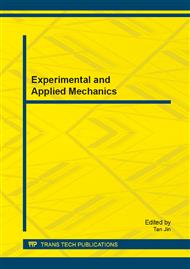p.178
p.184
p.190
p.196
p.201
p.209
p.215
p.220
p.225
Disturbance Sampling Analysis in Sediment of the Yellow River Reservoir by Finite Element Method
Abstract:
Based on the nonlinear finite element theory, the disturbance conditions of deep water reservoir sediment in the process of sampling with sampler are researched by using the finite element software ADINA. Nonlinear face-face contact model between sampler and sediment is established by adopting the Mohr-Coulomb constitutive model as sediments material properties, and the friction and contact in the interface of sampler wall and sediment are well simulated. The impact load is applied, and the impact sampling finite element simulation model is obtained by nonlinear transient dynamic analysis. The condition of deformation, stress and strain in sampling sampler is well discussed, the results show that the axial compression of sediment samples is largest on the bit lip surface and is smallest in the center part of the sediment samples, the impact disturbance on the soil samples is within a small scope nearby the bits.
Info:
Periodical:
Pages:
201-208
Citation:
Online since:
February 2014
Price:
Сopyright:
© 2014 Trans Tech Publications Ltd. All Rights Reserved
Share:
Citation:


